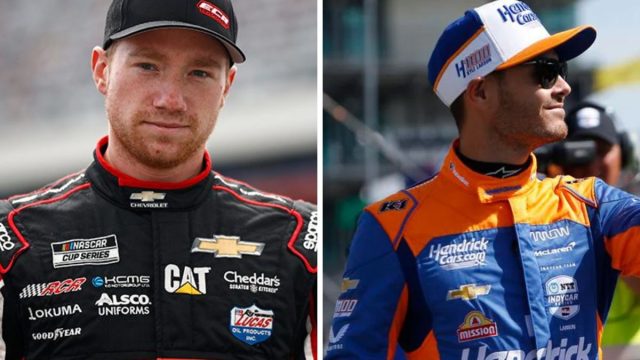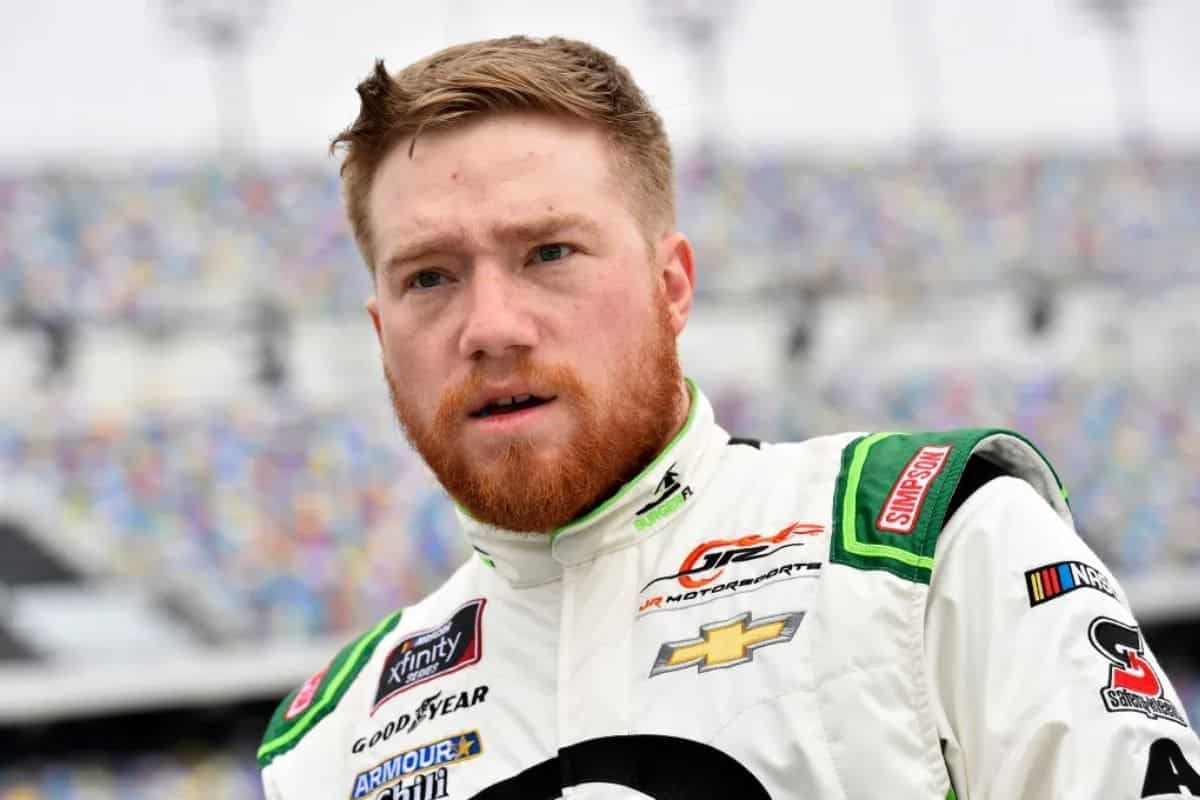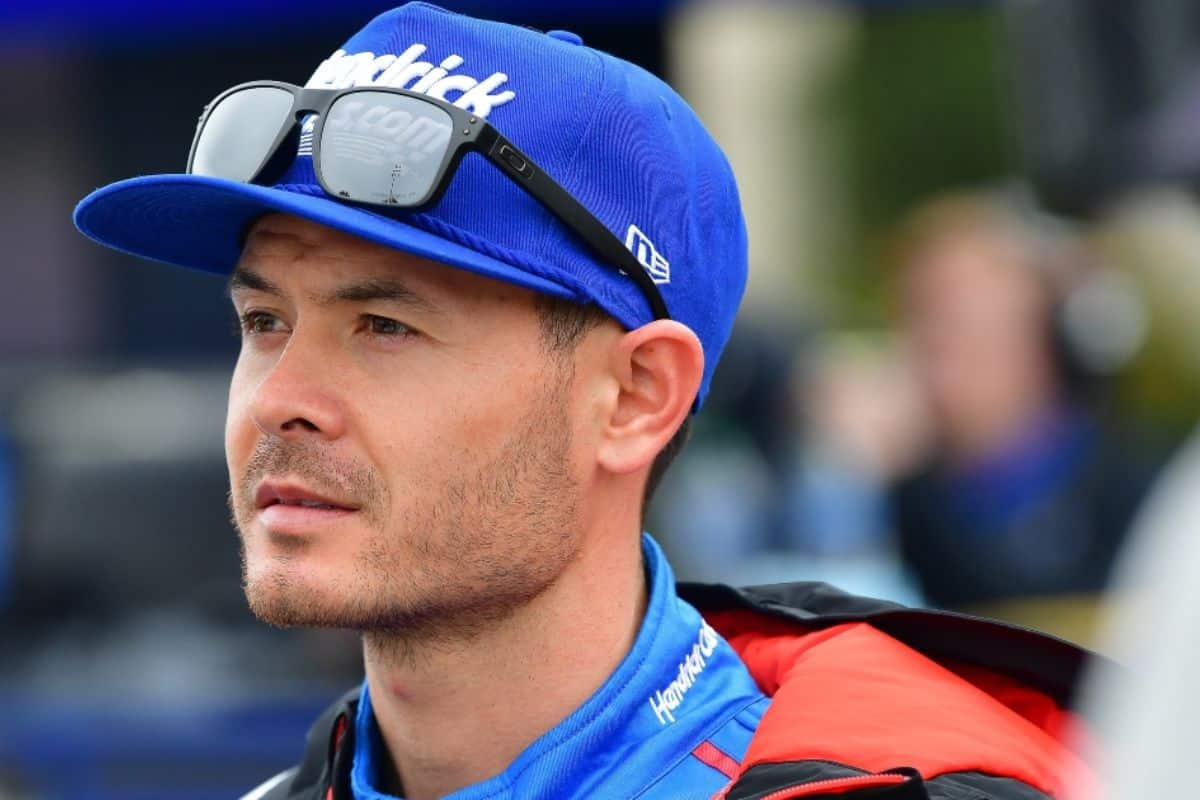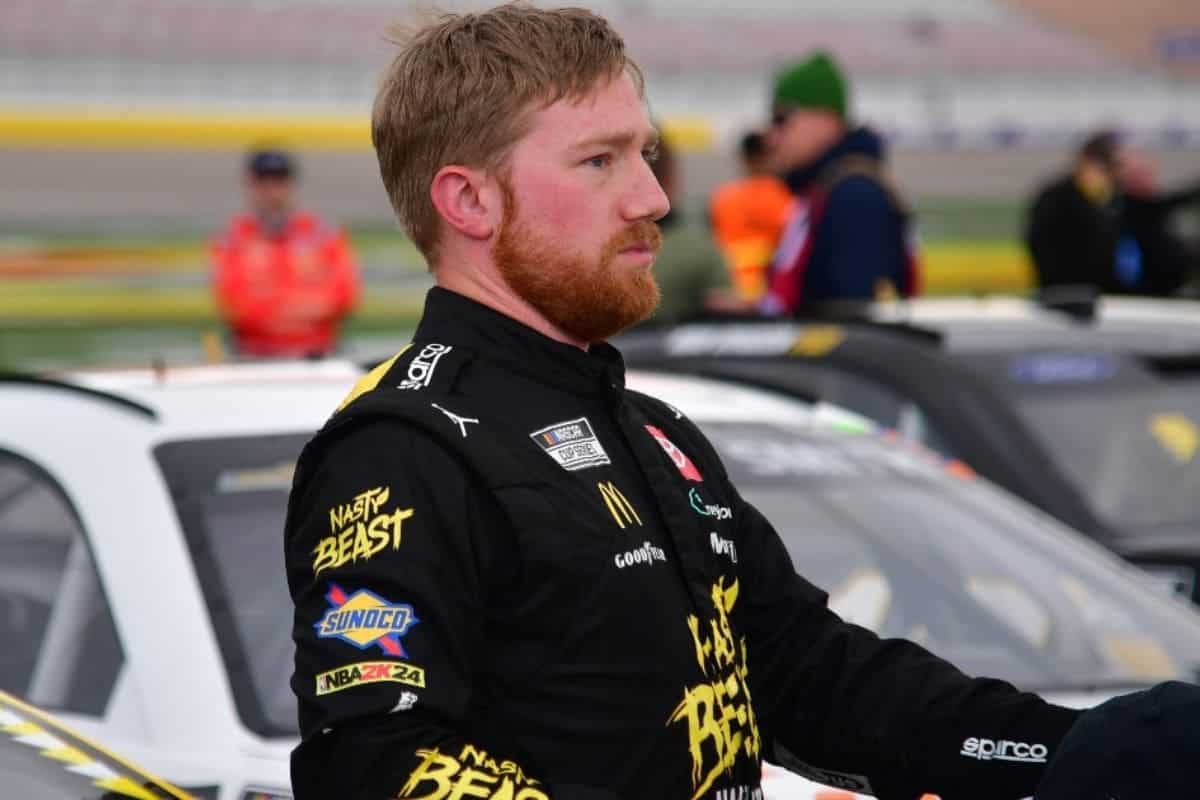Tyler Reddick Admits Defeat to Larson: The Sonoma Raceway witnessed an electrifying showdown as Tyler Reddick and Kyle Larson employed nearly identical strategies, yet the outcome highlighted the subtle intricacies of NASCAR. Reddick’s precision and tactical proficiency were evident, but it was Larson’s deftly timed delayed pit stop that secured his victory. In a commendable display of sportsmanship, Reddick acknowledged Larson’s superior execution. This acknowledgment not only amplifies the competitive spirit of the race but also invites a deeper examination of the slight differences that defined their respective performances.
Key Highlights
- Tyler Reddick acknowledged Kyle Larson’s superior execution despite their similar strategies.
- Reddick admitted deficiencies in his race performance compared to Larson.
- Both drivers employed delayed pit stop strategies, but Larson’s timing was optimal.
- Reddick’s strategic brilliance was reduced by race challenges and unpredictability.
- Larson’s victory highlighted the importance of precise decision-making in unpredictable racing conditions.
Sonoma Race Drama
Amidst the thrilling atmosphere of the Sonoma Raceway, the dramatic interplay of strategy and speed took center stage, as the race unfolded with a staggering eight cautions, nearly eclipsing the long-standing record set in 1990. The frequency of these caution periods forced teams to adapt from their initial race-day strategies, emphasizing the importance of adaptability in NASCAR’s road-course events. The chaotic dynamics on the track highlighted a crucial truth in motorsports: the finest-tuned machines and fastest drivers must still navigate the unpredictability of racing conditions and tactical gambits.
The Sonoma race’s distinctive challenge lies in its curve layout and elevation changes, demanding precision driving. Yet, it was the near-record caution flags that truly tested the mettle of the teams. Each caution was a double-edged sword, presenting potential opportunities for strategic pit stops and position gains, while simultaneously increasing the risk of falling out of competitive race. Teams had to carefully calculate fuel consumption, tire wear, and the timing of pit stops, often relying on split-second decisions by crew chiefs and spotters.
The teams were split into two main groups based on their strategies. One group opted for early pit stops, while the other chose to pit later. Kyle Larson decided to delay his pit stop, ultimately leading to his victory. However, it’s important to note that Tyler Reddick was the one who originally introduced this strategy, not Larson and his team.
Tyler Reddick’s Strategic Brilliance
Tyler Reddick’s strategic brilliance was on full display at Sonoma Raceway, where his tactical expertise and precise timing of pit stops demonstrated a deep understanding of the race’s evolving dynamics. Reddick’s ability to anticipate the flow of the race and make decisions that optimized his lead was nothing short of masterful. Leading for 35 laps and securing victory in stage one, Reddick’s strategy was carefully crafted to optimize his position on the track.
A crucial aspect of Reddick’s approach was his decision to delay his initial pit stop until stage two on lap 53, a move that allowed him to maintain a significant advantage during the early phase of the race. This delay was not simply a matter of convenience but a calculated strategy to capitalize on the race’s natural ebb and flow. By staying out longer, Reddick avoided the congestion and potential mishaps of early pit stops, ensuring that he remained at the forefront of the competition.
Following his initial pit stop on lap 53, Byron returned to the pits for his final stop on lap 68, just 15 laps later. This strategic decision bolstered his competitiveness for the remainder of the race. Moreover, Reddick’s sharp awareness of tire wear and fuel consumption facilitated his ability to stretch his performance without sacrificing speed or control. His strategic pit stops were timed perfectly, allowing him to rejoin the race with minimal loss of position, thereby maintaining his competitive edge.
Despite ultimately finishing eighth, Reddick’s performance at Sonoma was a demonstration of his strategic intelligence. His moves not only highlighted his skills as a driver but also showcased his ability to influence the race’s outcome through sheer tactical ingenuity.
Kyle Larson’s Winning Move
Larson waited to stop for new tires until later in the second stage, coming in on lap 52. Then, for his last pit stop, he came in on lap 80 and came back out in eighth place. But because his tires were fresher by 13 laps, he quickly caught up to the cars ahead and ended up winning. Despite Reddick’s strong showing and smart pit stops, he couldn’t keep up with Larson’s speed in the final laps. This makes us wonder if Reddick would have done better if he had also pitted on lap 80 like Larson did.
Larson’s decision to postpone his pit stop was a masterstroke, allowing him to capitalize on the superior grip and performance of fresher tires when it mattered most. As the race approached its climax, this advantage became increasingly evident. The fresh rubber provided Larson with enhanced traction and stability, essential in the high-speed corners of Sonoma’s challenging road course.
- Tire Management: Ensured minimal wear during initial stages, preserving the integrity for a strong finish.
- Racecraft: Demonstrated superior overtaking skills, efficiently moving through the field post-pit stop.
- Strategy Execution: Seamlessly implemented a race plan that balanced aggression with conservation.
- Adaptability: Adjusted his approach in response to the evolving race dynamics, showcasing flexibility and foresight.
Tyler Reddick’s Concession and Martin Truex Jr’s Disappointment
Reddick, despite emulating Larson’s strategic approach, openly acknowledged that his car’s speed deficiencies and a critical error during a restart ultimately cost him a shot at victory. In a frank post-race interview, Reddick highlighted the subtle differences that separated his performance from Larson’s. While both drivers utilized similar pit stop timings and tire strategies, Reddick’s No. 8 Chevrolet struggled to maintain the pace necessary to stay competitive. A crucial moment came during a late-race restart where a miscalculation saw him lose critical positions, further intensifying his struggle to regain lost ground.
“I was just stupid. I was on cold tires and it was going to be hard to hold him [ Larson] off anyway. I kind of just fell for it.” – (REDDICK)
Reddick’s admission emphasizes the fine margins that define success and failure in NASCAR. His recognition of Larson’s superior execution speaks volumes about the intense competition and razor-thin margins at this level of motorsports. The restart error, often a make-or-break point in races, highlighted Reddick’s need for refinement under pressure, an area where Larson’s experience shone through.
“I didn’t have a great restart, that also played a big factor. Even when we got some clear air after we put a second set of tires on, we didn’t seem as good.” – (REDDICK)
In Sonoma, many drivers had their efforts wasted, including Martin Truex Jr. With four previous wins at the track, fans expected him to equal Jeff Gordon’s record for the most wins in Sonoma. However, things turned out differently than expected.
Similarly, Martin Truex Jr’s day at Sonoma was plagued by unforeseen fuel complications. Coming into the race with an impressive track record, Truex was anticipated to be a strong contender. However, as the race unfolded, his No. 19 Toyota began to falter. Fuel issues forced Truex to adopt a cautious approach, ultimately dragging him down to a 27th-place finish. This performance not only dashed his immediate aspirations but also cast a shadow over his playoff prospects.
Truex’s disappointment is a stark reminder of the unpredictable nature of NASCAR. Mechanical reliability, often taken for granted, can turn the tide of a race, leaving even the most seasoned drivers grappling with unforeseen challenges. As Truex now shifts focus to upcoming races, the demands increase to secure crucial points for his playoff aspirations.
Reflections on the Race
Often characterized by its unpredictable nature, the Sonoma race served as a compelling example of how strategic brilliance can be rewarded and reduced by unforeseen challenges. Tyler Reddick and Kyle Larson, both employing similar strategies, demonstrated that even meticulous planning might not guarantee a victory. Reddick’s concession to Larson highlighted the razor-thin line between success and defeat in NASCAR, while Martin Truex Jr.’s fuel management woes highlighted how quickly fortunes can change.
- Fuel Management Challenge: Truex Jr.’s struggle with fuel highlighted the perennial challenge of resource management, a factor that can derail even the most well-executed plans.
- Driver Expertise: The race was a demonstration of the exceptional skill levels required to navigate the complexities of Sonoma’s road course, where every turn can be a potential game-changer.
- Team Collaboration: The importance of seamless communication between drivers and their pit crews was evident, as split-moment decisions often made the difference.
- Unpredictability: As always, the race reinforced NASCAR’s inherent unpredictability, reminding everyone that even the best-laid plans can be thrown off by unforeseen variables.
News in Brief: Tyler Reddick Admits Defeat to Larson
The Sonoma Raceway event highlighted the complex dynamics of NASCAR racing, where Tyler Reddick’s skilled strategy and decision-making ultimately fell short against Kyle Larson’s strategically superior delayed pit stop.
Reddick’s acknowledgment of defeat, compared with Martin Truex Jr.’s disappointment, exemplifies the sport’s competitive essence and the importance of recognizing and respecting the skill of fellow racers. This race serves as a proof of the relentless pursuit of excellence and the detailed strategies that define NASCAR competition.
Our Reader’s Queries
Q. Who is number 45 in NASCAR?
A. Tyler Reddick, behind the wheel of the No. 45 23XI Racing Toyota, is embarking on his fifth full season in the NASCAR Cup Series. His victory at Talladega Superspeedway marks his first win of the 2024 season, showcasing his skills on the track. Notably, Reddick secured two victories with 23XI Racing in 2023, winning at Circuit of The Americas and the fall race at Kansas Speedway, further solidifying his competitive edge in the series.
Q. Is Kyle Larson out of the championship?
A. NASCAR’s recent announcement confirmed that Kyle Larson retains eligibility to compete for the 2024 Cup Series championship, courtesy of a waiver granted to Hendrick Motorsports. The team sought this exemption following Larson’s absence from a race at Charlotte Motor Speedway last month, as he opted to participate in the Indianapolis 500 on the same day.
Q. Has Tyler Reddick won a race?
A. At the season finale held at Homestead, Reddick clinched victory in both the race and his inaugural Xfinity Series championship. His remarkable achievement echoed his dominance throughout the season. In 2019, Reddick’s exceptional performance, marked by five regular season wins, secured his entry into the playoffs, where he successfully defended his title. Notably, Reddick’s consecutive Xfinity championships mirrored a feat previously accomplished by Ricky Stenhouse Jr., showing his status as a standout talent in the series.
ALSO READ: Tyler Reddick on Sonoma Repave: “It Feels Sketchy”



